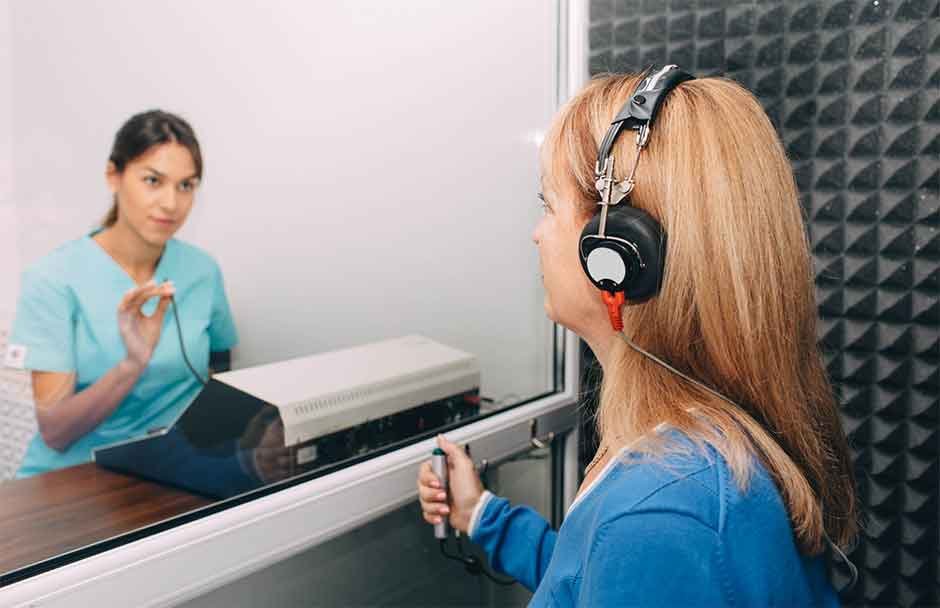Image credit: Oticon Medical
Article by Hearing Partners, contributed by Jennifer Lee, Senior Clinical Audiologist at Hearing Partners
A bone conduction hearing aid, also referred to as a bone conduction hearing system, is a specialised hearing device that transmits sound to the inner ear by sending vibrations through the skull.
This device transmits sound to the hearing organ without the need to wear something in the ear. This makes it an ideal option for individuals with external ear or ear canal abnormalities, or individuals who are prone to ear infections. It’s also suitable for those with unilateral hearing loss.
In this article, we’ll look at the candidacy for bone conduction hearing aids, as well as the mechanics behind these devices. We’ll also discuss the typical process for obtaining bone conduction hearing aids and the risks associated with this type of device.
Who Is Suitable for a Bone Conduction Hearing Aid?
A potential candidate must have bone conduction thresholds better than 65dBHL in at least one ear to benefit from a bone conduction hearing aid. It’s often recommended for individuals who have conditions such as, but not limited to:
- Structural abnormalities (collapsed ear canals or absence of ear canals)
- Middle ear abnormalities (Otosclerosis, Cholesteatoma, absence of ossicles)
- Recurrent ear infections or discharge
- Sudden hearing loss in one ear
As a result of these conditions, potential candidates generally have one of the following types of hearing loss:
- Conductive hearing loss
- Unilateral sensorineural hearing loss (profound)
- Mixed hearing loss
How Does a Bone Conduction Hearing Aid Work?
A bone conduction hearing aid can be worn as a headband, stuck on the skin directly with an adhesive, or attached to a surgically implanted abutment or magnet slightly above and behind the ear.

Image credit: National Deaf Children’s Society
Non-surgical methods are often the preferred options for young children, whose skull density is still unsuitable for implants, as well as adults who are medically unfit for surgery. Otherwise, a bone conduction implant would provide better physical comfort and sound quality than a headband or adhesive.
A conventional hearing aid channels sound into the ear via the usual hearing pathway (i.e. into the ear canal, through the eardrum and middle ear bones, and into the hearing organ). However, conventional hearing aids may have suboptimal clarity for this population as the sound transmission pathway is disrupted or hindered by the above-mentioned conditions.
On the other hand, a bone conduction hearing aid delivers sound through the temporal bone via large vibrations, bypassing the outer and middle ear, directly to the hearing organ. As such, a user has to have inner ear hearing thresholds better than 65dBHL to benefit from bone conduction hearing aids.
In contrast to cochlear implants, the use of bone conduction hearing aids preserves the hearing organ’s structure and the acoustic nature of sounds. A bone conduction hearing aid can be worn on one or both sides and it can be worn together with a conventional hearing aid or cochlear implant on the other side.
Process of Getting Bone Conduction Hearing Implants
If you think you could be a suitable candidate for a bone conduction hearing implant, here is an overview of the process of getting one.
Step 1: Take a hearing evaluation

First, you would need to undergo a consultation with an audiologist to assess your ear condition and determine the type and severity of your hearing loss.
During the session, the audiologist will discuss the potential hearing amplification options for your hearing configuration and ear condition. You might be able to try on the devices to experience and compare the sound quality. The audiologist would also evaluate your performance in sound detection and speech discrimination with the recommended devices.
Step 2: Discussion with an ENT doctor
If you and your audiologist have come to an agreement that a bone conduction implant is the best option, you’ll be referred to an ENT specialist who is familiar with bone conduction implants. There, you would discuss the suitability and risk of surgery and go through a medical assessment, including CT scans, to deem fit for the stated surgery.
Step 3: Undergo surgery
The implantation typically lasts an hour and will be performed under general anaesthesia. During this time, the internal component of the hearing device (e.g. screw fixture and abutment, or magnet) will be inserted.
Step 4: Activate the device
Following the surgery, there is a healing period of 2 to 4 weeks. Once you have fully healed and received clearance from the doctor post-surgery, your audiologist will attach the external component and activate the device. The bone conduction hearing aid would be tuned for the first time with the bone conduction thresholds from your hearing evaluation.
Step 5: Attend follow-up appointments
After your bone conduction hearing implant has been activated, you’re required to attend follow-up appointments with your audiologist to monitor its performance. The first appointment typically occurs 1 month after the device has been activated.
Subsequent appointments will be scheduled at regular intervals to make necessary adjustments to the device for optimal performance, monitor for any changes to the hearing levels, and facilitate technical checks on the external processor.
Risks of Bone Conduction Hearing Implants
Complications arising from bone conduction hearing implants tend to be mild rather than severe. These complications can be categorised into 2 main types: those related to the bone (hard tissue) and those related to the soft tissue.
| Bone complications | Soft tissue complications |
| ● Chronic infection
● Implant fails to integrate with the skull bone (failure of osseointegration) ● Trauma |
● Bleeding or hematoma formation
● Overgrowth of skin over the abutment ● Persistent pain ● Skin flap necrosis ● Skin irritation around the implant ● Wound dehiscence |
Bone Conduction Hearing Aid Brands and Systems
If you’re suitable for bone conduction hearing aids and have decided to proceed with the procedure, these are some brands and systems that are recommended by hearing care professionals and ENT specialists.
| Brand | System | Features* |
| Cochlear™ | Baha® System | ● Clear, rich and natural sound
● Improved listening in noisy environments ● Improved recognition of high-frequency consonants ● Wireless connectivity |
| MED-EL | BONEBRIDGE | ● Lightweight audio processor
● Intelligent hearing technology ● Natural sound quality |
| Oticon Medical | Ponto™ System | ● Tiny sound processor
● 360° soundscape ● Improved listening in noisy environments ● Powerful hearing technology for reduced listening effort ● Internet and wireless connectivity |
*The features may vary based on the model of the bone conduction hearing aid. Newer models may come with more advanced features.
You’re advised to speak to your ENT specialist or audiologist about the model of bone conduction hearing aid they recommend for your condition.

















Comments